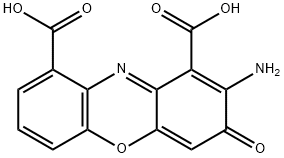Cinnabarinic acid is a phenoxazinone produced by the oxidative dimerization of 3-hydroxyanthranilic acid (3-HAA) as part of the metabolism of tryptophan in the kynurenic pathway. It acts as a partial receptor agonist of the metabotropic glutamate receptor 4 (mGlu4), effective at 100 μM, with no activity at other mGlu receptor subtypes. 3-HAA does not affect mGlu receptors, including mGlu4. Cinnabarinic acid induces apoptosis of T cells at 300-500 μM, a potency some ten times that of 3-HAA.
Cinnabarinic acid may be used in studies of the functions of components of the kynurenine metabolic pathway. It may be used to study it role as a metabotropic glutamate receptor (mGlu4R-specific) agonist.
A natural phenoxazinone derivative, Cinnabarinic acid is obtained in vitro with aid of laccase by oxidative dimerization of 3-Hydroxyanthranilic acid (a metabolite of the amino acid Trytophan). Cinnabarinic acid strongly induces apoptosis in thymocytes through the generation of reactive oxygen species and the induction of caspase.
A natural phenoxazinone deriv
Cin
nabarinic acid strongly induces apoptosis in thymocytes through the generation of reactive oxygen species and the induction of caspase.
ChEBI: Cinnavalininate is a phenoxazine.
Cinnabarinic acid is a kynurenine pathway metabolite of tryptophan, produced by the oxidation of 3-Hydroxyanthranilic acid. Cinnabarinic acid leads to loss of mitochondrial respiration and apoptosis, and has also been shown to be an mGlu4R-specific agonist.
1) Lowe?et al.?(2014),?Identification of cinnabarinic acid as a novel endogenous aryl hydrocarbon receptor ligand that drives IL-22 production;? PLoS One,?9(2)?e87877
2) Hiramatsu?et al. (2008),?Cinnabarinic acid generated from 3-hydroxyanthranilic acid strongly induces apoptosis in thymocytes through the generation of reactive oxygen species and the induction of caspase;? J. Cell. Biochem.,?103?42
3) Fazio?et al.?(2012),?Cinnabarinic acid, an endogenous metabolite of the kynurenine pathway, activates type 4 metabotropic glutamate receptors;? Mol. Pharmacol.,?81?643

